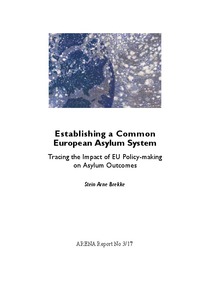Establishing a common European asylum system tracing the impact of EU policy-making on asylum outcomes
"Ever since the the Dublin convention entered into force in 1997, asylum seekers have been given a common status in all of Europe: If an asylum application is rejected in one country, the persons right to apply for asylum in other European countries is revoked. For this system to be just, all p...
| Main Author: | |
|---|---|
| Institution: | ETUI-European Trade Union Institute |
| Format: | TEXT |
| Language: | English |
| Published: |
Oslo
2017
Arena |
| Subjects: | |
| Online Access: | https://www.labourline.org/KENTIKA-19396415124911146979-establishing-a-common-european.htm |
| Summary: | "Ever since the the Dublin convention entered into force in 1997, asylum seekers have been given a common status in all of Europe: If an asylum application is rejected in one country, the persons right to apply for asylum in other European countries is revoked. For this system to be just, all participating countries would need to have common procedures for their handling of asylum applications: A condition that has repeatedly been proven not to be fulfilled. In order to solve these discrepancies, the European Union has implemented numerous directives and measures intending to harmonise European asylum procedures over the last decades: However, previous studies have found these efforts to be futile, with differences remaining largely the same or even increasing. This thesis sets out to conduct a more thorough study of the convergence of European asylum recognition rates, by seeing the results of quantitative convergence studies in light of the EU policy development process. It finds that the increased discrepancies of asylum recognition rates observed in previous studies are likely to be the result of \textit{unfinished convergence}, and concludes that EU directives implemented as a part of the Common European Asylum System are likely to cause a harmonisation of European asylum procedures in the long run. Compared to previous studies, this thesis thus argues for a less pessimistic interpretation of convergence of asylum recognition rates, finding indications that recognition rates are converging following the implementation of EU policies." |
|---|---|
| Physical Description: | 113 p. Digital |

